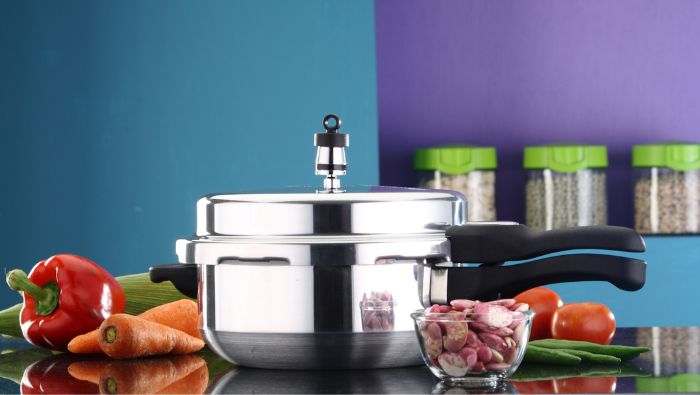Pressure Cooker Perks: Why You Should Have One in Your Kitchen

Do the words “pressure cooker” bring fear to your heart? Do you have visions of Grandma’s double-decker aluminum monolithic model needing a forklift to move it? Do you fear permanent facial scaring from flying pressure cooker shrapnel and scalding tomato bits?
If so, please consider the time, money and energy savings a pressure cooker can bring to your kitchen.
A Little About Pressure Cookers
Food Network’s Chef Alton Brown assures us that pressure cookers today are safe, efficient, and user friendly. They come in a variety of sizes, from large canning models to medium-sized stockpots to others hardly bigger than a frying pan. Electric or stovetop varieties are available. They can be used for cooking meats, rice, legumes, and vegetables, as well as for traditional pressure canning.
French innovation first led to steam technology in 1679. Napoleon later used this unique way to avoid food spoilage as a military secret. Word eventually leaked out of France, and pressure cooking became widespread. America’s use of pressure cooking became rather fickle since WWII but eventually made a comeback. European and Asian cooks have continuously used this method due to low energy usage. We would be wise to follow their lead.
Chef Arlyn Hackett says, “We are in the new age of pressure cookers.” Our user-friendly second-generation pressure cookers come in aluminum or stainless steel with a variety of features like precision spring valves and safety locking devices, which only allow opening when the pressure level is safe.
Sign Up for Savings
Subscribe to get money-saving content by email that can help you stretch your dollars further.
Twice each week, you'll receive articles and tips that can help you free up and keep more of your hard-earned money, even on the tightest of budgets.
We respect your privacy. Unsubscribe at any time.
Saving Time Saves Energy Costs
Pressure cooking reduces cooking time, usually using only a third of stovetop cooking time and much less than that for slow cooking. This cuts the energy costs for cooking. An electric pressure cooker uses 110 volts rather than 220; both types keep a summer kitchen cooler.
Broccoli, cauliflower, green beans, potatoes, carrots and other root vegetables all cook in under five minutes. Even an artichoke that might take an hour to cook in boiling water will be done in twelve minutes. Rice takes eleven minutes. Whole chickens and roasts are falling off of the bones in flavorful tenderness in less than an hour.
Saving Time Saves Food Costs
It also encourages home-cooked meals.
- A wholesome soup can be made in 30 minutes, feeding a family for a fraction of the price of buying hearty soups in a can.
- Pressure cooking tenderizes less expensive cuts of meat and cooks whole chickens rather than more expensive chicken parts.
- Chicken, beef, pork and venison fall from the bones and make perfectly shredded meat, which can be used in soups, stews, sandwiches, salads and casseroles. (I add onion, celery and garlic, and at times, I also add bay leaf, green chilies, Cajun, Mexican or Asian spices to the meat for mouthwatering flavor and excellent broth.)
- Meats and broths/stocks can be frozen in recipe-sized portions to be quickly pulled out for easy future meal preparation, saving time and money on those meals too!
It’s a wise, time-conscious investment.
Saving Time Promotes Healthy Choices
In our fast-paced lifestyles, many families find themselves running for fast foods or buying processed foods that have less preparation time. These are often less healthy foods filled with additives, salt, saturated fats and high-calorie counts. Those foods contribute to health problems connected to obesity, diabetes, high cholesterol and high blood pressure. Eating healthy can save money on medical costs.
Pressure cooking uses minimal amounts of water so nutrients remain in the food and are not poured down the drain. When using a pressure cooker, you control what you eat. Consider buying and eating fresh foods that can be pressure-cooked (not overcooked) and ready to eat in minutes.
Reviewed February 2024
Popular Articles
- 7 Habits of Highly Frugal People
- 5 Simple Budget Cuts That Can Save $200 a Month
- How to Track Down Unclaimed Funds Owed You
- 32 Ways to Save Money on Your Utility Bills
- Do You Need Credit Life Insurance When Buying a New Car?
- How to Maximize Profits When Selling Online
- Staying Motivated to Continue Digging Yourself Out of Debt
On After50Finances.com
- 9 Things You Need to Do Before You Retire
- You Didn’t Save Enough for Retirement and You’re 55+
- When Empty Nesters Reorganize and Declutter Their Home
- Reinventing Your Career in Your 50s or 60s
- What Mature Homeowners Should Know about Reverse Mortgages
- 2 Reasons to Collect Social Security Benefits As Soon As Possible


